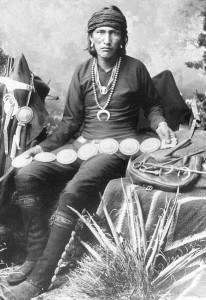When looking for a piece that truly complements every style, try looking at southwest necklaces. Much like a little black dress, a southwest necklace can be dressed up or down to fit any occasion. When looking to purchase a southwest necklace it may be helpful to understand the different designs offered and how the designs came to be. This will make the necklace even more special when you invest in the statement piece.

Southwest necklace designs vary but the easiest way to tell a difference is by the materials used. Materials include beads, shells, copper, silver, ivory, amber, turquoise and other stones. Early on the materials used were based on the area in which the jewelry was produced and the available trade in the area. Before Europeans came to America, copper was primarily used and commonly hammered and etched to create necklaces and other types of jewelry. Evidence of shells and stones used as jewelry can be found as early as 6000 B.C. while excavations in the Southwest have found turquoise in southern Arizona that dates back to 200 B.C.
After the 1800s, once the Spanish had introduced silver and other novelties southwest necklaces really started to transform. The Navajo started using the stamping method where metal stamps were used to decorate the surface of a metal with designs, either raised or incised. When the depressed areas are oxidized, the pattern stands out. The Zuni tribe is known for the inlay method in which cutting, shaping and polishing stones creates a pattern in the metal. Once the form is created, stones are then selected to place within the pattern. Hopi’s are known for the overlay method where they soldering two sheets of silver together to create a two-or three-dimensional pattern.
Through the stamping method the iconic Navajo squash blossom necklace was developed. Squash blossom is a term used to describe a unique necklace produced by Southwestern Indians. The “blossom” portion and the end of the necklace is actually a Moorish crescent moon, a direct product of the Spanish influence. This popular type of Southwest necklace was first made by the Navajo and later by the Zuni and Hopi Indians. The Hopi also created overlay necklaces and the Zuni Indians used turquoise inlay designs for necklaces, bracelets and rings. Cluster jewelry is also popular technique using several stones set in a deep setting with a rim.
Southwest necklaces have many styles with a rich history within the Southwest jewelry community. Each style is unique and fitting for different personalities. The squash blossom necklace pairs nicely with a simple work outfit. The cluster southwest necklace can make a cocktail dress “pop”. Whatever your style, there is a southwest necklace for everyone.
